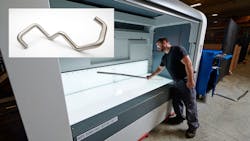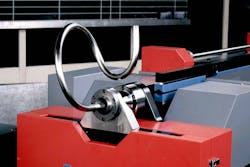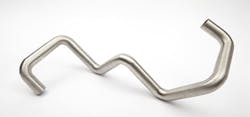At a Glance:
- While applications vary by industry, quality metal fabrication conforms to several basic rules and requires fundamental processes.
- While there are many bending solutions and strategies, nothing can get properly accomplished without proper tooling.
- Understanding the fundamental processes, tools and terms in the metal fabrication discipline can help ensure a successful project outcome.
The metal fabrication industry consists of numerous different segments, from large OEMs that supply the machine technology needed for creating parts to smaller, more specialized shops that build to customer demand. Many markets rely on this type of manufacturing, as in some cases it is more cost-effective to outsource this work than to invest in the resources and develop the skills needed to do the work onsite.
In aviation and aerospace, part forming is commonly needed to create rotors, landing gear and hydraulic controls; for automotive, custom formed metal tubing may be used for heat exchangers and exhaust manifolds; and for food and beverage, bent tubing is needed for commercial serving tables as well as the piping used in craft brewing equipment.
In the furniture and fixtures industry, you’ll notice tube and pipe in chair legs, rounded frames for tables or metal safety bars for bathrooms. For many medical and healthcare equipment companies, formed pipe and tube is used to construct patient beds, as handles and frames for mobile supply carts and disinfectant equipment, and in the institutional seating found all over clinics and hospitals.
The recreation industry relies on metal fabricators for custom tube bends that form the frames for seating or structures in public playgrounds and parks, or for off-road recreational vehicles such as ATVs or related equipment. In the commercial building space, you’ll find ornamental metal fabricators that focus on highly curated metal work, as well as those that focus on standard metal parts for more discrete structural applications.
Identifying Bending Methods
When it comes to bending pipe or tube, there are several methods used to achieve a quality, custom-formed part. The primary bending methods are compression bending, roll bending, freeform bending and mandrel bending (also called rotary draw bending), which is the most common method. Here is more detail about each of these techniques:
Compression Bending
This is a simple method of bending pipe or tube where the bend die stays stationary while a counter die bends or compresses the material around the stationary die. This method requires a bend die that is the size of the desired bend radius. The material is then formed around the bend die, without the use of a mandrel.
Roll Bending
Roll bending is typically used for large radius bending. In this process a piece of pipe or tube rotates through three rollers that are in a triangle configuration. The two outer rollers, usually stationary, cradle the bottom of the material while the inner roller, which is adjustable, presses on the top of the material. This method is ideal for large radius bends and is best suited for producing large, wide radius sweeps.
Freeform Bending
Freeform bending uses one set of tooling to bend variable or multiple radii. Normally pipe and tube bending requires a bend die, a clamp die, a pressure die and sometimes a wiper; with freeform bending, the material is continuously guided through the machine using one die that is the size of the pipe or tube being bent. Most any radius can be achieved using a single die set.
Rotary Draw or Mandrel Bending
One of the most precise methods, CNC rotary draw bending is probably the most tooling-oriented. As many as six tooling sets may be needed for a project, based on its size and scope. Of these, the three most important types are the bend die, pressure die and clamp die. Depending on the bend radius and wall thickness, a mandrel, wiper and collet may also be needed
Within this discipline is also multi-radius bending, which is commonly used for complex parts when one continuous pipe or tube requires two or more center line radii. It is a good fit for parts with a large centerline radius, where hard tooling may not be an option, or for complex parts that need to be formed in one complete cycle.
Designing products with components that require custom tube or pipe forming can be more involved than it may initially appear. Factors such as tooling, materials and labor play a role in the approach to bending and associated services.
Multi-radius bending is ideal for exhaust and emissions control, oil and gas, and other process applications where interior surfaces must be consistent in order to withstand pressure, flow rate and volume of the material going through the tube or pipe. This type of bending is also used to create components for heavy equipment and a variety of structural frames.
Let’s Talk About Tooling
Regardless of the amount of bending equipment available, nothing can be done without the right tooling. There several different types of tooling used in bending based on the application or end-use.
The bend die is central to the tube forming process, as it rotates to form the center line radius. A concave channel on the die mates with the outside diameter of the tube or pipe, helping to hold the material while it is being bent.
The pressure dies mates up with the tube, adding stability as the tube wraps around the bend die. The clamp die works in tandem with the pressure die, holding the tube against the straight section of the bend die as it turns.
When needed, the wiper die is used. Riding toward the end of the bend die, this tooling helps to smooth out the surface along the inside radius as the tube or pipe moves through the bend, preventing wrinkles and supporting the tube wall.
A mandrel is a bronze alloy or chrome plated steel insert that supports the pipe or tube on its inside. Its purpose is to prevent the tube from collapsing and minimize ovality.
The collet grips onto the tube during the bend process, rotating it into position for the next bend. It softly closes onto the outside of the tube, guiding and moving it into place.
Depending on the size of the material being bent and the annual usage, it is sometimes necessary to create bend dies if none exists for the particular project. This type of upfront investment can range from $2,000 to $20,000 and is sometimes amortized across the life of a project.
If there is flexibility to adjust the part specification, an alternative is to consider using an existing bend die with a similar radius to the original part design, thus saving on cost and lead time to produce; however, sometimes this is unavoidable.
Terms in Custom Bending
For custom bending of metal tube and pipe, there are several standard terms that are widely used when determining feasibility and scope of work required for a project. Here are a few of the commonly used keywords you’ll hear if working with a metal fabricator for this type of job:
Center line radius. As a general rule, the tightest achievable center line radius is one times the pipe or tube diameter. Whenever possible, try to choose a center line radius of one-and-a-half times or greater than the tube diameter to save labor costs. Check your vendor’s tooling list to help you make this selection.
Wall thickness. When bending pipe or tube, the wall on the outside radius can thin up to 33%, depending on the radius and other factors. This is important to keep in mind if your application involves high pressure or flow, as a thicker wall may be necessary to achieve the desired results.
Straight length between bends. Typically, a straight dimension between bends should be two to three times the tube diameter, depending on the radius. Tubes with little or no straights between bends can be done using freeform bending, which in some cases may require additional tooling.
Tolerances. The industry standard is still considered to be ±1 deg. on bend angles. Tighter tolerances to 0.2 deg. can be achieved with laser spring back technology, if required by the application. Lineal tolerances are normally ±0.062 in. or tighter. The industry standard for ovality is 8% and can be lessened as needed.
Drawings. When submitting part drawings, it is important to include the pipe or tube specs, material type, center line radius, tolerances and any other details about the scope of the project. Be sure to include model files along with a PDF for easy viewing and analysis.
Designing products with components that require custom tube or pipe forming can be a more involved task than it initially appears. Factors such as tooling, materials and labor play a role in the approach to bending and associated services. And although the available machine technology for tube bending has evolved over the years, many of the variables remain the same. Having a basic understanding of what is involved in custom tube bending, and consulting with a trusted supplier, will help support the design process while informing project timelines and costs.
Patrick Coenen is a project engineer for Sharpe Products. He manages custom tube bending and tube lasering projects from start to finish. Prior to this, he held operations and manufacturing engineering roles in tube and sheet metal fabrication, stamping and welding. Coenen studied engineering at the University of Wisconsin-Milwaukee.
About the Author
Patrick Coenen
Project Engineer, Sharpe Products
Patrick Coenen is a project engineer for Sharpe Products. He manages custom tube bending and tube lasering projects from start to finish. Prior to this, he held operations and manufacturing engineering roles in tube and sheet metal fabrication, stamping and welding. Coenen studied engineering at the University of Wisconsin-Milwaukee.




